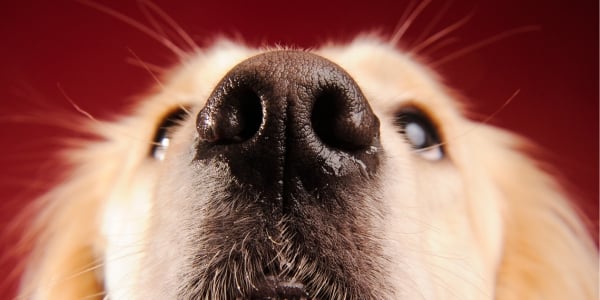
If you're anything like me, you want to boop your dog's nose multiple times a day. It's such an adorable part of their face, but it also plays a crucial role in your dog's experience of the world — their sense of smell is integral to how they "see" everything.
And did you know that dog's nose prints are as unique to them as our fingerprints are to us?
There are some myths and facts about our furry friends' noses, and since sharing is caring, we are going to share them.
Additionally, we thought it would be helpful for you to have some ‘nose care’ tips to help keep that sniffer in good shape so it can always be in the know.
Skip to section:
The Truth About Your Dog's Nose
When it comes to dog noses, there are some amazing facts, and then there are some misconceptions or ‘old wives’ tales. Let’s see if you know which is which!
Fact or Fiction?: Dogs Have an Additional, Secondary Organ in Their Nose.
True: Dogs have what is known as the Jacobsen’s organ or the vomeronasal organ. It is important in the detection of particular smells, such as pheromones, which are essential in mating. You may see your dog using this olfactory organ when they "taste" a smell, quickly chattering their teeth together or tapping their tongue on the roof of their mouth.
Fact or Fiction?: When a Dog’s Nose Is Dry and Warm, They Are Sick and Have a Fever.
False: While dogs that are sick can have a dry and warm nose, healthy dogs can, too.
Weather, especially when it is dry and hot, can cause your dog’s nose to be dry. Additionally, when your home is very dry during the winter months, your dog’s nose will be drier.
Tip: If you live in a dry climate, one with low humidity, or your home is dry in the winter due to the heater, consider using a cool mist humidifier. The added moisture will benefit your dog and you. For some dogs, especially seniors or those with respiratory issues, that little bit of extra moisture feels good to their nose and mucous membranes. And for those who tend toward having a very dry nose, it will help soothe some of the dryness and perhaps prevent further irritation or cracking. Your pet doesn't have to be directly in front of the mist for it to be beneficial. As long as the humidifier and your pet are in a small room, they will benefit from the mist.
If your dog is eating, drinking, and happily playing a warm and dry nose is likely normal.
However, if you are concerned your dog may be sick and have a fever, you can take their temperature (greater than 102.5 F is a fever) or contact your veterinarian.
Fact or Fiction?: A Dog’s Nose Must Be Wet for Them to Be Healthy.
False: Generally, the moistness of your dog’s nose isn’t a good indicator of their overall health. Some dog noses are naturally drier as compared to others. Additionally, a drier nose is common among older dogs as compared to younger ones.
Some reasons your dog’s nose may be dry:
- Breed type: Short-snouted dogs, such as Pugs, can struggle licking their nose so it will tend to be drier. There are breeds, such as Lhasa Apsos, that tend to have blocked tear ducts, which can cause the nose to be drier.
- Allergies: Dogs with environmental, food, or skin-related allergies all tend to have drier noses.
- Sunburn: Just like people can suffer from sunburn, so can dogs, and their nose is a common location for it to occur, especially if they have pink or pale noses and light coats. Sunburn can cause their nose to become dry and even crack. Read more about sunburn and dog-safe sunscreen in our article, Do Dogs Need Sunscreen?
- Autoimmune disease: There are some autoimmune diseases, such as discoid lupus or pemphigus, that can cause your dog’s nose to become dry, cracked, crusty, and bleeding. If your dog’s nose appears to be unusually dry, crusty, or bleeding, contact your veterinarian.
See below for more information about diseases that affect dogs' noses.
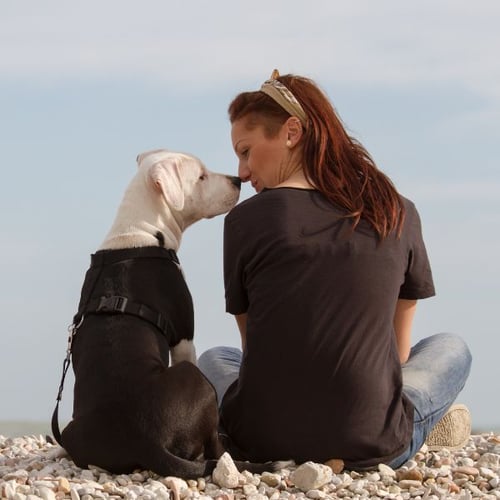
Fact or Fiction?: Compared to People, a Dog’s Sense of Smell Is More Specialized and Sensitive.
True: The number of smell-sensitive receptors in dogs is about forty times that of humans. It ranges from 125 million to nearly 300 million in certain breeds, such as the Bloodhound. (Plus, the Bloodhound's long floppy ears work to create a funnel toward their nose that kicks up and intensifies scents.)
Dogs use their sense of smell to obtain essential information about their environment, recognizing other dogs, people, or animals, to make decisions, and to learn. Smelling another dog's urine can tell them about the dog's age, sex, reproductive status, and if they are sick. They can also tell how long ago that dog passed by and then find out which direction by finding any sweat left behind from the dog's paw pads.
Fact or Fiction?: All Dogs Have an Excellent Sense of Smell.
False: The sense of smell of all dogs is excellent, BUT brachycephalic breeds (e.g., Bulldogs, Frenchies, or Boston Terriers) have less sensitivity to odor as compared to non-brachycephalic breeds. Find out how the shape of their nose impacts their sense of smell and causes more health issues in the next section.
Diseases That Affect Dog Noses
Discoid Lupus
Discoid lupus erythematosus (DLE) is an autoimmune disease. This form of lupus causes lesions that are generally associated with the nose and can extend up the bridge of the nose. Lesions can also affect the ears and mouth.
Loss of nose pigment is one of the early signs. Dog owners may notice that the black of the nose becomes bluish-grey or possibly pink. The skin then starts to become scaly and crusted, and ulcers eventually develop.
It is important to have your dog evaluated by a veterinarian if you notice any of these changes.
Breeds predisposed to discoid lupus:
-
Alaskan malamute
-
Beagles
-
Brittany
-
Collie
-
Chow Chow
-
German shepherd
-
Irish setter
-
Old English sheepdog
-
Poodles
-
Siberian husky
-
Shetland sheepdogs
This poor Portuguese Water Dog, while not a breed typically predisposed, did have discoid lupus. Before diagnosis, he suffered from a cracked and bleeding nose. In the photo below, he has a few stitches holding together several open spots. He ended up living until 15.5 years old, and his nose healed perfectly once he was on medication for lupus.
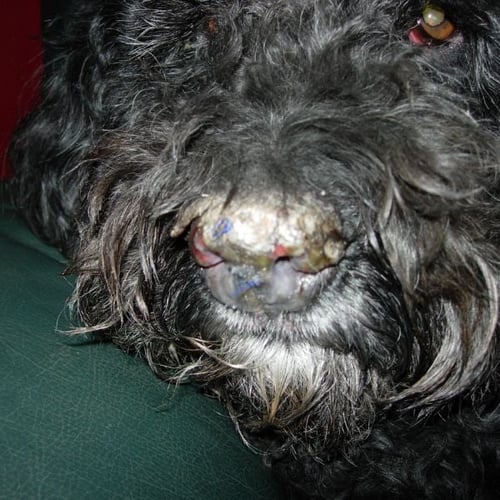
Pemphigus
The most common autoimmune disease in dogs is pemphigus foliaceus.
The disease affects the outermost superficial layer of skin called the epidermis, and it is characterized by erosions (e.g., superficial ulcers, crusts, and inflamed, small, pus-filled lesions.
It can occur at any age, but the average age of onset is around six years old.
Breeds predisposed to pemphigus:
-
Akita
-
Bearded Collie
- Chinese Shar Pei
-
Chow Chow
-
Collie
-
Doberman Pinscher
-
English springer spaniel
-
Newfoundland
-
Schipperke
Hyperkeratosis
This condition occurs when a dog’s body produces too much keratin. This protein is what helps form hair, nails, and the skin’s outer layer. Its cause varies from genetics to underlying medical issues to hormonal imbalances. This condition can also affect your dog's paw pads.
Hyperkeratosis is common in the following breeds:
-
Bassett hounds
-
Beagles
-
Bedlington Terriers
-
Bordeaux
-
Boxers
-
Bulldogs
-
Cocker spaniels
-
Golden Retrievers
-
Irish Terriers
-
Labradors
-
Sharpei
Other Conditions
There are other conditions that can cause a dog’s nose to crust and/or develop erosions (e.g., superficial ulcers). Some of these conditions include:
-
Ringworm on the nose
-
Skin infection on the bridge of the nose
-
Pemphigus foliaceus (see below)
-
Hyperkeratosis (see above)
-
Nasal lymphoma (a type of cancer)
See below for some ways to help your dog if they have a dry nose.
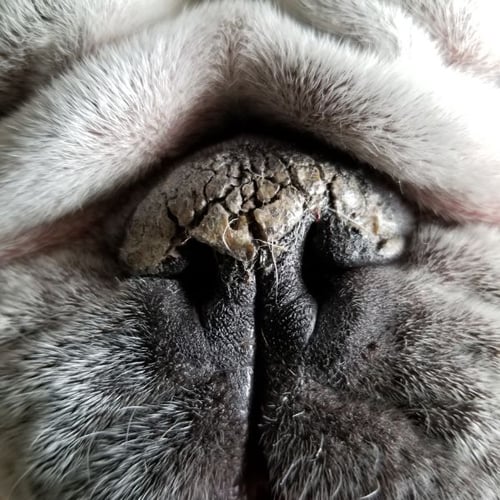 Why Brachycephalic Breeds Have More Nose Issues
Why Brachycephalic Breeds Have More Nose Issues
While the smush-faced or flat-faced breeds are completely adorable, in my opinion — the conformation of their face can cause them some issues.
Brachycephalic breeds often have one or more narrow (stenotic) nostrils, which affects how much air moves in and out of the nostrils. This can affect how moist or dry their nose is as well as affect their breathing. If your dog has this issue, consult with your veterinarian. Learn more about brachycephalic syndrome.
Due to the conformation of their faces, very short noses, and wide heads, it is harder for them to lick their nose, and they tend to have less contact with surfaces in their environment. Both factors can affect the moistness of their nose.
Brachycephalic breeds tend to have smaller tear ducts, which can lead to a drier nose since the tear ducts connect to the nasal canal. Additionally, these breeds develop dry eye (keratoconjunctivitis sicca or KCS) more commonly than non-brachycephalic breeds. Therefore, a deficiency in tears will cause their nose to be drier. Using artificial tears may help.
The abnormal conformation of the skull results in folds of skin over the nose region called nasal folds. Moisture can become retained in these folds, leading to an overgrowth of yeast and bacteria, which can cause skin irritation, swelling, and infection.
Additionally, these folds can rub the eyes causing tearing irritation. Both of these conditions can cause them to rub their face on the floor, furniture, or other objects, leading to, you guessed it, a dry nose.
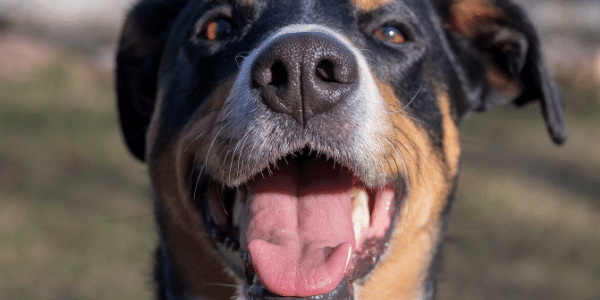
Tips for Caring for Your Dog’s Nose, Folds, and All
If your dog seems to have an unusually dry nose, especially if they are a brachycephalic breed or one predisposed to lupus or pemphigus, be sure to have them evaluated by their veterinarian.
As mentioned, a dry nose can be completely normal, but it is always best to have your veterinarian sniff around for any underlying medical issues.
Just like we like some relief for our dry skin and nose, so does your dog. Here are some products you can apply to their little sniffer to help keep the tissue moist.
Dry Nose Relief
You don’t need to apply a lot. A little can go a long way.
-
Bag Balm (also good for human use)
-
Coconut oil (also good for human use and cooking)
-
Vitamin E oil (Note: Be sure that you are only using pure vitamin E and that it doesn’t contain any other ingredients, such as xylitol, which can be toxic.) (also good for human use)
-
Jojoba oil (also good for human use)
Note: Especially for any dog with respiratory issues, such as asthma or collapsing trachea, select an unscented option.
In addition to topical products, consider giving your dog, Omega 3 fatty acids and pre/probiotics to help support their skin and body from the inside. See our recommended pet-safe fish oils and chews.
Improve Decreased Tears
Decreased tear production can cause dryness in a dog’s nose. It can be a result of dry eye, but also allergies, and a drier environment.
Dry eye needs to be managed by prescription medications. However, it and the other mentioned causes can be helped by applying preservative-free artificial tears to the eyes three to four times daily. Be sure to never touch the bottle directly to your dog’s eye or surrounding skin, as it may harm your pet but also contaminate the nozzle and liquid for future use.
Nasal Folds
Keeping your dog’s nasal folds clean and dry is important to prevent discomfort and infection.
There are a variety of wipes you can use to keep your dog’s nasal folds fresh and clean. For most dogs, the folds need to be cleaned at least three to four times per week. For dogs with deep folds or those dealing with an infection, your veterinarian may recommend cleaning once to twice daily.
When cleaning the folds, be sure to use light pressure and don’t rub aggressively back and forth, as this can cause further irritation. Use extra caution when cleaning the folds near the eyes, as you don’t want to irritate them.
Here are some wipes that help keep nasal folds clean:
-
Non-medicated options for general cleaning:
-
Medicated wipes: For dogs that have issues with yeast or repeated bacterial skin infections, using these wipes several times per week (3 to 4) in addition to non-medicated wipes may help better control the yeast and lessen the frequency of bacterial infections.
-
Squishface Wrinkle Wipes – Deodorizing and Tear Stain Remover
-
For dogs that suffer from chronic severe irritation or infection in their folds or those that suffer from eye issues due to the folds, your veterinarian may recommend nasal fold resection. This is a surgical procedure that decreases the skin folds.
Remember, we are all in this together. So, if you have any tips or tricks for keeping your dog’s nose moist and healthy, please share them with us! Or, if you have any questions, feel free to ask in the comments below.



